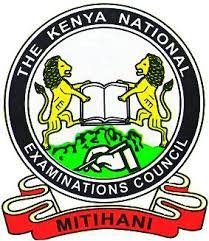
3.5.3 Physics Paper 3 (232/3)
Question 1
PART A
You are provided with the following:
a metre rule
3 optical pins
2 small wooden blocks
a stop watch
a stand, a boss and clamp
a piece of sellotape
Proceed as follows:
a) Using the two wooden blocks, clamp two optical pins about 4 cm apart in the stand so that they project out of the blocks in a horizontal plane.
(b) Using a piece of sellotape, attach the third optical pin across the metre rule at a distance x = 1O cm from the 50 cm mark. Now suspend the metre rule on the two clamped pins so that it can swing freely in a vertical plan with the third pin as the axis. (See figure 1)

(c) Displace the lower end of the metre rule slightly and let it oscillate as shown in the figure 1.
Measure and record in table l the time t(s) for 20 oscillations. (Correct to one decimal place).
(d) (i) Repeat the procedure in (b) and (c) for the values of X shown in table 1.
(ii) For each value of x shown in the table, determine the period T(s), correct to two decimal places, and complete the table. (The period T is the time for one complete oscillation).

(e) On the grid provided, plot a graph of T2X(y-axis) against X2 (origin not required). (5 marks)
(f) From the graph, determine:
(i) the slope S of the graph. (3 marks)
(ii) the value of constant r given that:
rS = 39.5 (2 marks)
PART B
You are provided with the following:
– a converging mirror
– a rectangular piece of manilla paper
– a half meter rule
– a stand, boss and clamp
– a dropper
– liquid Q
Proceed as follows:
(g) (i) Using the wooden blocks clamp the manilla paper in the stand so that it projects out of the blocks in a horizontal plane, about 30 cm above the bench.
(ii) Place the mirror on the bench so that its centre is vertically below the free end of the manilla paper.
(h) With your eye vertically above the free end of the manilla, observe its inverted diminished image appearing as in figure 2.

(i) Now adjust the height of the manilla vertically above the centre of the mirror until its width and that of the inverted image are equal as in figure 3.

Measure and record the distance L1 between the manilla paper and the bench. L1 = …………………….. ..cm (1 mark)
(j) Using the dropper provided put some liquid Q on the mirror so that its surface is about 3 cm in diameter. Repeat part (i). Measure and record the distance L2 between the manilla paper and the bench. L2 : ……..cm (1 mark)
(k) Determine constant k given that:
L1 = kL2 (2 marks)
Question 2
You are provided with the following:
four 10 Q resistors
a resistance wire labelled S mounted on a half metre rule
a resistance wire AB mounted on a metre rule
two dry cells and a cell holder
a centre zero galvanometer G
8 connecting wires each with a crocodile clip at one end
a jockey
a micrometer screw gauge
a switch
(a) Set up the circuit as in figure 4 in which R is nearA and S is near B. (R is a 10 Q resistor or an appropriate combination of 10-ohm resistors).

(b) Starting with a single 10 Q resistor as R, close the switch. Using the jockey tap wire AB briefly near end A and observe the deflection on the galvanometer. Now tap the wire near end B and again observe the deflection of the galvanometer. (The two deflections should be in opposite directions)
(c) Still with the 10 Q resistor as R, tap at various points along wire AB to obtain a point P at which the galvanometer shows zero deflection. Measure and record in table 2 the length L (m) between A and P. (Record L correct to 3 decimal places)
(d) Repeat part (c) to obtain L for other values of R shown in table 2. (6 marks)
Determine:
(i) 1/L for all the values of L correct to 2 decimal places. (1 mark)
(ii) 1/R for all values of R correct to 3 decimal places. (1 mark)

On the grid provided, plot a graph of 1/L (y-axis) against 1/R (origin not required). (5 marks)
(i) Determine the slope n of the graph. (3 marks)
(ii) State the unit of n. (1 mark)
Using the micrometer screw gauge, measure and record the diameter D of wire S in metres. D : …………………………. .. m. (1 mark)
Determine the value of constant k given that 4k=rnD2n(3 marks)
